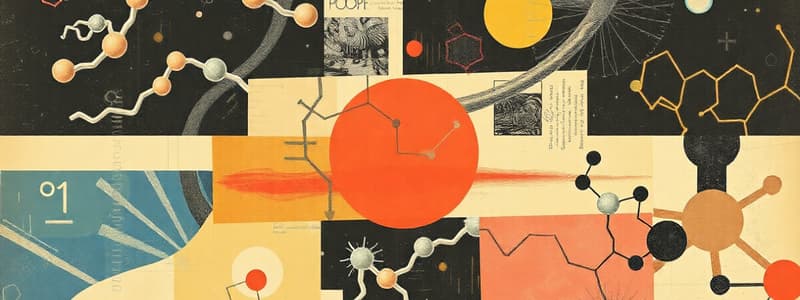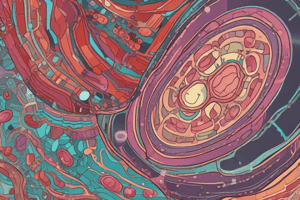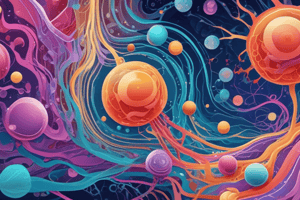Podcast
Questions and Answers
Which of the following vitamins is NOT water-soluble?
Which of the following vitamins is NOT water-soluble?
- Folic acid
- Vitamin C
- Vitamin B12
- Vitamin A (correct)
What is the primary function of minerals in the human body?
What is the primary function of minerals in the human body?
- Regulating body temperature
- Providing energy for cellular processes
- Facilitating chemical reactions and providing structural components (correct)
- Serving as the main structural component of cells
What is the most accurate description of the primary structure of a protein?
What is the most accurate description of the primary structure of a protein?
- The combination of multiple polypeptide chains
- The three-dimensional shape of a protein molecule
- The arrangement of alpha-helices and beta-pleated sheets
- The sequence of amino acids in a polypeptide chain (correct)
At what level of protein structure do interactions between R-groups primarily dictate the final 3D shape?
At what level of protein structure do interactions between R-groups primarily dictate the final 3D shape?
What process is responsible for disrupting a protein's tertiary structure, potentially leading to a loss of function?
What process is responsible for disrupting a protein's tertiary structure, potentially leading to a loss of function?
What is a key structural feature of saturated fats that distinguishes them from unsaturated fats?
What is a key structural feature of saturated fats that distinguishes them from unsaturated fats?
Why is cholesterol considered essential for the human body?
Why is cholesterol considered essential for the human body?
What is the role of High Density Lipoproteins (HDLs) regarding cholesterol?
What is the role of High Density Lipoproteins (HDLs) regarding cholesterol?
Which transport process uses protein channels to move molecules down the concentration gradient?
Which transport process uses protein channels to move molecules down the concentration gradient?
What is the main distinction between active and passive transport?
What is the main distinction between active and passive transport?
Which of the following is an example of bulk transport that involves the engulfment of large particles?
Which of the following is an example of bulk transport that involves the engulfment of large particles?
During which phase of the cell cycle does a cell replicate its DNA?
During which phase of the cell cycle does a cell replicate its DNA?
During which mitotic phase are sister chromatids pulled apart towards opposite poles?
During which mitotic phase are sister chromatids pulled apart towards opposite poles?
Which of these processes is a form of endocytosis that is very specific in the molecules it brings into the cell?
Which of these processes is a form of endocytosis that is very specific in the molecules it brings into the cell?
What is the key purpose of mitosis in multicellular organisms?
What is the key purpose of mitosis in multicellular organisms?
In what phase of mitosis do chromosomes line up at the cell's equator?
In what phase of mitosis do chromosomes line up at the cell's equator?
During which phase of mitosis do chromatids begin to de-condense and the nuclear membrane reforms?
During which phase of mitosis do chromatids begin to de-condense and the nuclear membrane reforms?
What is the primary outcome of cytokinesis in mitosis?
What is the primary outcome of cytokinesis in mitosis?
Which of the following is NOT a key significance of mitosis?
Which of the following is NOT a key significance of mitosis?
During which phase of meiosis does crossing over occur?
During which phase of meiosis does crossing over occur?
What is the main difference between Anaphase I of meiosis and anaphase of mitosis?
What is the main difference between Anaphase I of meiosis and anaphase of mitosis?
What is the ploidy of the cells after telophase I of meiosis?
What is the ploidy of the cells after telophase I of meiosis?
What is a significant difference between the products of mitosis and the products of meiosis?
What is a significant difference between the products of mitosis and the products of meiosis?
What process ensures that offspring inherit a combination of genetic traits from both parents?
What process ensures that offspring inherit a combination of genetic traits from both parents?
What is the primary function of the alveoli?
What is the primary function of the alveoli?
What role does hemoglobin play in oxygen transport?
What role does hemoglobin play in oxygen transport?
What is the pH range that hemoglobin must be maintained at for optimal function?
What is the pH range that hemoglobin must be maintained at for optimal function?
Which process occurs in the alveoli to facilitate gas exchange?
Which process occurs in the alveoli to facilitate gas exchange?
What is produced when oxygen binds with the iron in hemoglobin?
What is produced when oxygen binds with the iron in hemoglobin?
What structure directs air into the trachea?
What structure directs air into the trachea?
What is the primary structural feature of the nasal cavity that aids in filtering air?
What is the primary structural feature of the nasal cavity that aids in filtering air?
What distinguishes deoxy-hemoglobin from oxy-hemoglobin?
What distinguishes deoxy-hemoglobin from oxy-hemoglobin?
What are fossils primarily composed of?
What are fossils primarily composed of?
Which term describes structures in different organisms that share a recent shared ancestry?
Which term describes structures in different organisms that share a recent shared ancestry?
What type of evidence for evolution involves examining similarities in DNA sequences?
What type of evidence for evolution involves examining similarities in DNA sequences?
What does the term 'vestigial structures' refer to?
What does the term 'vestigial structures' refer to?
Archaeopteryx is significant because it is considered:
Archaeopteryx is significant because it is considered:
Which of the following is NOT an example of analogous structures?
Which of the following is NOT an example of analogous structures?
Which of the following statements about pseudogenes is true?
Which of the following statements about pseudogenes is true?
How do analogous structures differ from homologous structures?
How do analogous structures differ from homologous structures?
What is the primary function of salivary amylase in carbohydrate digestion?
What is the primary function of salivary amylase in carbohydrate digestion?
Which enzyme is responsible for protein digestion in the stomach?
Which enzyme is responsible for protein digestion in the stomach?
Adaptive radiation refers to which of the following?
Adaptive radiation refers to which of the following?
Which of the following is NOT involved in fat digestion?
Which of the following is NOT involved in fat digestion?
In which part of the digestive system does carbohydrate digestion cease?
In which part of the digestive system does carbohydrate digestion cease?
Which digestive enzymes are produced by the pancreas for protein digestion?
Which digestive enzymes are produced by the pancreas for protein digestion?
What is the role of bile in fat digestion?
What is the role of bile in fat digestion?
Which process describes rapid evolutionary changes followed by long periods of stability?
Which process describes rapid evolutionary changes followed by long periods of stability?
Flashcards
Passive transport
Passive transport
Movement of substances from a high concentration to a low concentration, without using energy.
Facilitated diffusion
Facilitated diffusion
A type of passive transport that uses helper proteins for large molecules to enter the cell.
Active transport
Active transport
Movement of substances from a low concentration to a high concentration, requiring energy.
Bulk transport
Bulk transport
Signup and view all the flashcards
Endocytosis
Endocytosis
Signup and view all the flashcards
Pinocytosis
Pinocytosis
Signup and view all the flashcards
Phagocytosis
Phagocytosis
Signup and view all the flashcards
Receptor-mediated endocytosis
Receptor-mediated endocytosis
Signup and view all the flashcards
Water-soluble vitamins
Water-soluble vitamins
Signup and view all the flashcards
Fat-soluble vitamins
Fat-soluble vitamins
Signup and view all the flashcards
Deficiency disease
Deficiency disease
Signup and view all the flashcards
Primary protein structure
Primary protein structure
Signup and view all the flashcards
Tertiary protein structure
Tertiary protein structure
Signup and view all the flashcards
Saturated fats
Saturated fats
Signup and view all the flashcards
Unsaturated fats
Unsaturated fats
Signup and view all the flashcards
Cholesterol
Cholesterol
Signup and view all the flashcards
Telophase (Mitosis)
Telophase (Mitosis)
Signup and view all the flashcards
Cytokinesis
Cytokinesis
Signup and view all the flashcards
Mitosis
Mitosis
Signup and view all the flashcards
Prophase I
Prophase I
Signup and view all the flashcards
Anaphase I
Anaphase I
Signup and view all the flashcards
Telophase I
Telophase I
Signup and view all the flashcards
Meiosis II
Meiosis II
Signup and view all the flashcards
Meiosis
Meiosis
Signup and view all the flashcards
Alveoli
Alveoli
Signup and view all the flashcards
Gas Exchange in Alveoli
Gas Exchange in Alveoli
Signup and view all the flashcards
Oxygen Diffusion
Oxygen Diffusion
Signup and view all the flashcards
Oxygen Transport
Oxygen Transport
Signup and view all the flashcards
Hemoglobin
Hemoglobin
Signup and view all the flashcards
Oxy-hemoglobin
Oxy-hemoglobin
Signup and view all the flashcards
Deoxy-hemoglobin
Deoxy-hemoglobin
Signup and view all the flashcards
Hemoglobin pH
Hemoglobin pH
Signup and view all the flashcards
Competition
Competition
Signup and view all the flashcards
Parasite or Host
Parasite or Host
Signup and view all the flashcards
Adaptive Radiation
Adaptive Radiation
Signup and view all the flashcards
Gradual Equilibrium
Gradual Equilibrium
Signup and view all the flashcards
Punctuated Equilibrium
Punctuated Equilibrium
Signup and view all the flashcards
Carbohydrate Digestion
Carbohydrate Digestion
Signup and view all the flashcards
Protein Digestion
Protein Digestion
Signup and view all the flashcards
Fat Digestion
Fat Digestion
Signup and view all the flashcards
Fossil
Fossil
Signup and view all the flashcards
Paleontology
Paleontology
Signup and view all the flashcards
Archaeopteryx
Archaeopteryx
Signup and view all the flashcards
Homologous Structures
Homologous Structures
Signup and view all the flashcards
Analogous Structures
Analogous Structures
Signup and view all the flashcards
Vestigial Structures
Vestigial Structures
Signup and view all the flashcards
Pseudogenes
Pseudogenes
Signup and view all the flashcards
Similar Amino Acid Sequences
Similar Amino Acid Sequences
Signup and view all the flashcards
Study Notes
Biodiversity
- Taxonomy is the science of naming, identifying, and classifying species, relying on observable traits (morphology).
- Domains include: Eukarya, Bacteria, and Archaea.
- Kingdoms include: different groups of organisms like plants, animals, etc.
- Taxonomic levels, from broadest to most specific, are: Domain, Kingdom, Phylum, Class, Order, Family, Genus, and Species.
Cell Structure
- Eukaryotic cells are larger than prokaryotic cells.
- Eukaryotic cells have a nucleus and membrane-bound organelles.
- DNA is organized into linear chromosomes in a eukaryotic cell.
- Prokaryotic cells are smaller and lack a nucleus or membrane-bound organelles, instead having DNA in a nucleoid region and a circular chromosome.
- Both have a cell membrane and ribosomes.
Viruses & Viruses Life Cycle
- Viruses are not living organisms and cannot reproduce on their own; they need a host cell.
- Basic structure includes a protein coat and nucleic acid(DNA or RNA).
- Bacteriophages are viruses that infect bacteria.
- The lytic cycle involves viral replication that results in the destruction of the host cell.
Protists
- Protists are eukaryotic organisms that are not plants, animals, or fungi.
- They exhibit various methods of movement including pseudopodia, flagella, and cilia.
- They can be autotrophic, heterotrophic or both.
- Examples: Euglena, Paramecium, and Amoeba.
- Protists reproduce asexually by mitosis or sexually by alternation of generations.
Fungi
- Fungi are heterotrophs, obtaining nutrients by secreting enzymes that digest organic matter.
- Fungi consist of hyphae, forming a mycelium; yeasts are unicellular.
- Some fungi form symbiotic relationships called mycorrhizae with plants, aiding in nutrient absorption.
- Fungi reproduce sexually or asexually.
- Major groups include: Zygomycota, Basidiomycota, and Ascomycota.
Studying That Suits You
Use AI to generate personalized quizzes and flashcards to suit your learning preferences.




